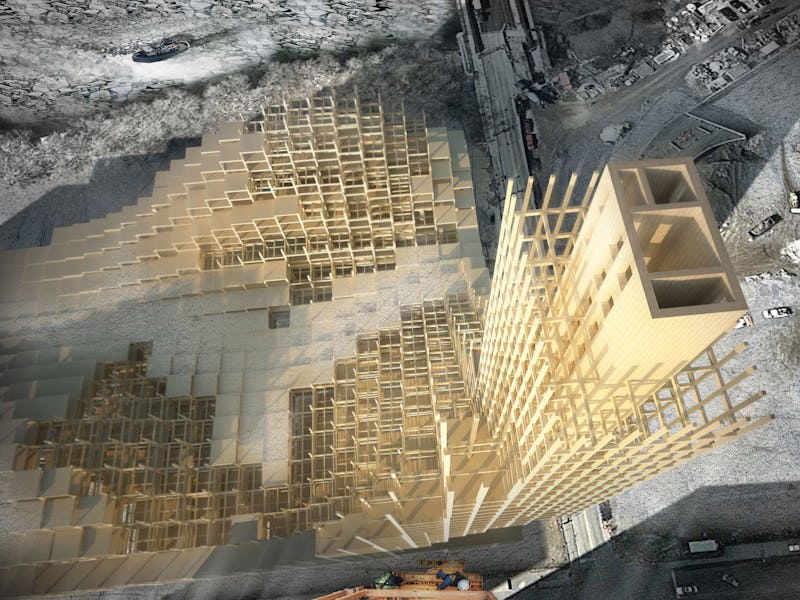Wood Skyscrapers Are the Gorgeous, World-Saving Future of Urban Skylines
The construction industry desperately needs a natural-look makeover.

The skyscrapers that populate the world’s cityscapes are iconically, indelibly, and undeniably built from concrete and steel. But what if they weren’t? Some architects are leading the charge to get back to nature and embrace the best construction material on Earth: wood. Proponents argue that wood skyscrapers will be safer and more beautiful than their forebears. More importantly, they could save the world.
Concrete and steel are staples of architecture rooted in cheap oil. They are enormously energy-intensive to produce, accounting for nearly 11 percent of greenhouse gas emissions and a carbon footprint essentially equal in size to that of all cars and trucks. Runaway climate change is the unintended (but now well understood) consequence of building cities with concrete and steel, and time is running out to radically change how we construct our environments, or face a crisis of unimaginable magnitude.
Wood as a construction material isn’t just less energy-intensive to produce, it actually has the potential to be carbon-negative. You probably learned in second grade science the cute story of trees breathing in the air we exhale, and that piece of information is crucial in understanding the eco-friendly benefits of using wood for skyscrapers.
In a TED Talk, Architect Michael Green estimates that each skyscraper built from wood could save the planet 4,300 tons worth of CO2 emissions — nearly 1,200 tons of carbon dioxide are produced from constructing a skyscraper out of concrete and steel, while 3,100 tons are sequestered in the same construction process using wood. “That’s the equivalent of about 900 cars removed from the road in one year,” Green says.
Wooden skyscrapers of the future could look like this.
If the idea of chopping down trees to save the planet sounds fishy to you, it’s because it is. Worldwide deforestation contributes a huge amount to climate change each year. But forestry is good for the planet if it’s done sustainably, meaning (among other things) that enough trees are planted to replace those taken, so that the forest can maintain or increase its rate of carbon consumption. Chad Oliver, director of Yale’s Global Institute of Sustainable Forestry, tells Popular Science that strategic lumbering can actually contribute to the well-being of the atmosphere and the species who inhabit these areas.
Construction workers laying down huge panels of cross-laminated timber
Certain forested areas can benefit from a calculated mix of areas with a dense population of trees and alternately more open, less densely populated sections, says Oliver. “Some animals live in that dense forest, but other animals live in an open forest. You need a diversity of conditions.” With a strategic approach that promotes biodiversity, Oliver claims that human intervention in heavily forested areas can actually benefit the animals that live there. Plus, smart logging reduces the risk of major conflagrations by preventing flames from spreading quickly: sparse areas create interruptions between heavily forested areas, allowing time for rain or colder weather to douse a fire.
This 18-storey wooden building will be built in Vancouver, Canada.
Don’t worry about those beautiful, tall trees that have existed for centuries, either: Logging to cultivate construction material can repurpose more slender and shorter trees that would normally go to waste. Lumber producers are using powerful polyurethane glues to bind smaller pieces of wood into enormous panels called cross-laminated timbers, which are much stronger than concrete and about one fifth the weight. The sheer size of these panels, coupled with the light weight, has allowed architects to dream up design plans that are simply unfathomable with steel and concrete.
While wood’s environmentally sound benefits are perhaps the most compelling, cross-laminated timber provides a number of other advantages. The reason construction sites are usually so damn loud and messy is because they involve working with steel and concrete — wood construction sites, on the other hand, produce less noise and mess. It also takes less time to build with wood, which cuts the costs of construction by a significant amount, even if wood is currently more expensive than steel and concrete. A wooden skyscraper may sound like a fire waiting to happen, but proponents say they might actually be safer. The reality is that steel melts and bends when heat is applied; Wood timbers will char on the outside but remain structurally intact.
Another mockup of buildings made out of cross-laminated timber
Won’t the whole thing just topple over in a breeze, like the house of little pig who chose to build with sticks? Come on. Wood is amazingly light and strong. The giant redwoods of California accomplish feats of engineering unfathomable to humans. If you can’t imagine a wooden skyscraper, it’s only because you haven’t seen one yet. But that’s going to change — there are dozens of tall wooden structures under construction or being planned worldwide. And while it would be cool if you could see their wooden skeleton, when they’re done they’ll just look pretty much like buildings — like superheroes in plainclothes.